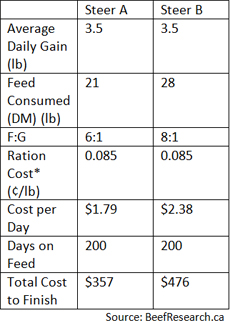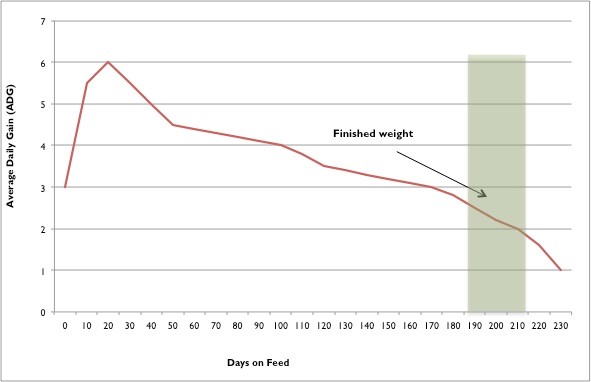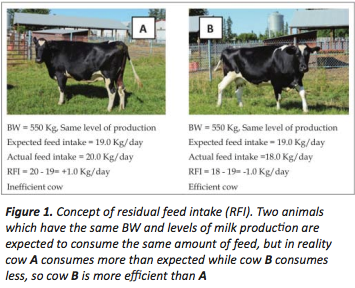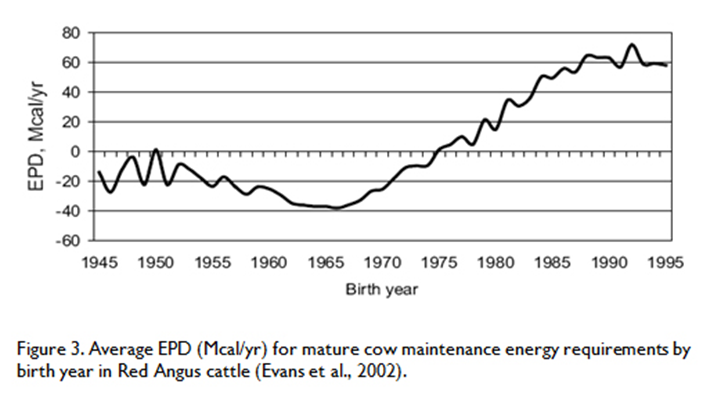Introduction

Intensive livestock systems differ from most pasture-based systems in that managers exert much greater control over the production cycle and the quality of animals entering the system. Consequently, technical inefficiencies among animals tend to be much more easily eradicated. This is especially so when the intensive livestock system in question operates under experimental conditions. Nevertheless, a range of factors could still cause both technical inefficiency and variations in productivity between animals and across breeds:
- variations in the genetic potential of sires and dams;
- variations in environmental conditions prior to animals entering the backgrounding phase of the production cycle (the phase when feedlot managers take control of the animals);
- catch-up effects when genetic advances between breeds take place at different rates.
- inherent differences in the productive potential of breeds in feedlotting, especially between temperate and tropically adapted breeds where it is expected that the former would be more productive than the latter; and
- different rates of genetic advances between breeds.
The expenses of purchasing a calf and the feed needed to finish it are the two largest variable costs facing the cattle feeding sector. Using less feed to finish a calf would substantially improve profitability in beef production and may diminish environmental implications. Feed costs are high due to poor growing conditions in major grain producing countries, because of the use of feed grains in ethanol production, and because of increasing competition of land for crop production versus urban development.
Feed to Grain Ratio
The feed to gain ratio (F:G) is a key measure of efficiency. Also known as the feed conversion ratio (FCR), F:G is a measure of an animal's efficiency in converting feed nutrients into increased body mass. F:G is an important variable in the cost to finish an animal. Because of the variability of water content, feed is measured by dry matter (DM).
Imagine two steer calves placed on feed. Both steers are gaining an average of 3.5 pounds per day (1.59kg/day). Over time, we measure that Steer A consumes an average of 21lbs (9.53kg) DM per day, which equates to a 6:1 feed to gain ratio. Steer B consumes 28lb/day (12.70kg/day), a F:G of 8:1, and therefore is less feed efficient than Steer A. Based on a ration cost of $187/tonne* (or 0.085 cents per pound), Steer A costs $1.79 to feed per day. Steer B costs $2.38 per day. If both steers reach their finish weight in 200 days, the less feed efficient animal (Steer B) would cost the producer $119 more to finish than an animal with better feed efficiency (Steer A). (*Note: this example may not reflect current feed costs.)
This example illustrates the importance of improving and maximizing feed efficiency in cattle on feed, which can make or break profitability in the feeding sector.

Diet Management
Substituting forage with grains in finishing rations can lead to substantial improvement in feed efficiency. Steers fed higher grain diets grow faster, finish sooner, and produce heavier and fatter carcasses1. Research also suggests that the type and quality of grains and the balance of essential nutrients, like vitamins, proteins, and trace minerals, significantly impact feed efficiency. Balanced rations increase average daily gain and can decrease feed cost per pound of gain. In order to prevent acidosis, it is necessary to appropriately adjust cattle from forage-based feed to high-energy grain-based rations.
Click here to view a video that explains rumen acidosis.
Digestibility of grains like corn, barley and oats is improved when grains are processed. By cracking the outer shell of the grain, rumen microbes are better able to utilize grain starch and minerals. Processing also allows grain to be mixed with supplements and affects palatability and passage rates. However, processing grains too finely leads to acidosis. Finding the ideal method and level of processing contributes to an improved F:G.

Analysis indicates that production costs would be 10% higher if producers did not use implants, ionophores or beta agonists.
Growth promotants are among the many sophisticated tools used by feedlots and other producers to raise more beef, more rapidly, using less feed, while maintaining high standards of animal health, carcass quality and food safety. Growth promotants include ionophores, growth implants, and beta-agonists.
Determining when an animal has reached its finished weight is an important aspect to feed efficiency. Once an animal’s rate of gain slows, most of the feed consumed is converted to waste fat rather than useable meat, and therefore is not cost effective. Producers can weigh and track individual animals or pens in order to track gains and determine when finished weight is reached.

Genetics
In addition to management practices that optimize feedlot feed efficiency, selecting cattle that are genetically feed efficient is important. Much research has been done to make genetic improvements in feed efficiency by measuring Residual Feed Intake (RFI). Advances in producing terminal animals through crossbreeding also maximize gains, grading and dressed yield. Improving the feed efficiency of a herd can mean big savings for producers. A 5% improvement in feed efficiency could have an economic effect four times greater than a 5% improvement in average daily gain (ADG). Since feed costs represent greater than two thirds of total production costs in a beef operation, reducing them can have huge advantages to your bottom line. This information isn’t only for the feedlot and backgrounding operation. It is especially true for the cow-calf producer because over 70% of those feed costs are going towards just maintaining the cows over the majority of the year.

The figure below shows how, for the cow herd portion only on a farm, the costs of production resulted in negative returns on investment for the average of all Alberta Agri-Profits producers 11 out of 16 years. The low-cost producer (the top 1/3 of the Agri-profits participants) saw negative returns on investment 6 out of 16 years. Considering the tough times in 2003 with BSE and the increasing feed prices from 2006 onward, knowing that 70% of beef production costs are feed related, the targeted selection for improved feed efficiency in the cow herd will only improve the return on investments (ROI’s). No one wants to be that average producer, we all want to be above average. We have to watch our inputs and outputs and focus on those aspects that result in long term gain.

Measuring Feed Efficiency
If you ask an average cattle producer how they measure feed efficiency in their herd, most would say by looking at the feed to gain ratio (Feed: Gain) or the feed conversion ratio (FCR). Basically, this is the calculation of the feed consumed per unit of weight gained. However, what this measure does not tell you is what the individual animals are eating. It only gives you a group average. While a group average might be useful in a feedlot situation, it really is of little value to a breeding herd where you want to make progress through genetic selection. Many beef cattle breed associations have adopted a slightly different method of evaluating individual feed efficiency, called residual feed intake, or RFI.
Residual feed intake is defined as the difference between an animal's actual feed consumed, or eaten, and the animal’s calculated feed requirements based on its body weight and ADG during a standardized test period. Essentially, RFI describes the variation in feed intake that remains after the requirements for maintenance and growth have been met. Efficient animals eat less than expected and have a negative or low RFI, while inefficient animals eat more than expected and have a positive or high RFI.
More recently, RFI values have been adjusted for body fatness (RFIfat), thus attempting to render RFI independent of carcass fatness in slaughter cattle and later maturity or fattening in replacement heifers and bulls. Similarly, another measure referred to as residual gain (RG) is adjusted for body size and dry matter intake (DMI). It represents animals with superior gain at equal levels of body weight and DMI. A trait that combines both RFI and RG, referred to as residual intake and gain (RIG), represents metabolically efficient, fast growing animals that consume less feed. These latter two measures of feed efficiency should also be adjusted for body composition using final off-test ultrasound backfat thickness, marbling score and/or ribeye area. These measures of feed efficiency are heritable and either moderately (RFI vs. RG) or highly (RG vs. RIG) correlated with each other.
For the beef cow, both the measures of DMI and ADG are related to body size, growth and composition of gain. Thus, selection for improved FCR has resulted in cattle that grow faster (increased ADG), have increased mature size, and increased maintenance and feed requirements. We’ve already been doing this and we produced a larger framed cow who ate more. Figure 3 shows the feed maintenance requirements for cows over this 50-year period. While it’s true that the cow size increased, so did their feed requirements - substantially.
If you take a look at the show ring heifer champions over the years during this same time period, you’ll see a drastic change in frame size from the 50’s to the early 80’s and a return to a more moderate frame size by the early 2000’s.

What we still don’t know about these replacement females is how much they ate for the performance they had. On the other hand, we do know that these breeders selected these heifers based on more than one trait. Structural correctness, conformation, docility, and their ability to breed and raise a calf were all considerations in their breeding programs; so, we can’t forget that. Even though we have a great tool to measure feed efficiency in the RFI trait, it has to be taken into account with the other traits of economic value. For a cow-calf producer, fertility is 10 times more important than carcass traits and 5 times more important than growth traits. Single trait selection is never a wise decision nor a practical goal to pursue.
Seedstock producers and breed associations have effectively used expected progeny differences (EPD’s) to improve the genetic merit of their cattle. However, these have been primarily for traits including growth and carcass which have put an emphasis on income and revenue generation leading producers to place a high value and level of importance on these traits to sustain their operation. What has been forgotten to some extent is the selection for factors that could lower costs within the production cycle, like feed efficiency. Measuring and selecting for the inputs and not just the outputs needs some attention for the beef operation to continue generating income, but also to enhance sustainability and save costs.
Selecting cattle for their feed efficiency using the RFI trait is the best measure we currently have as a direct measure of metabolic efficiency, or energy conservation because it is independent of body weight, average daily gain and backfat thickness. In any population there is variation in feed efficiency, and there will be individuals that can achieve high rates of gain with low feed intakes just as there will be individuals achieving low rates of gain with high feed intakes and others in between. Our challenge comes in measuring cattle for this trait, interpreting the numbers and using the data for genetic progress.
Figure 4 compares the progress that has been made in dry matter intake and the resulting feed costs throughout the 1990’s at an Australian Research Centre regarding actual selection for feed efficient cattle by using RFI. The negative RFI (high efficiency cattle) have reduced their dry matter intake per day by close to 0.5 kg resulting in significant feed savings to the beef operation. However, given that multi-trait breeding goals will be pursued by the industry, the researchers assumed an annual rate of response in RFI of -0.08 kg DM/day (0.8%/year) in a 25-year simulation compared to not selecting for RFI. Much progress can be made in improving feed efficiency well into the future as each generation improves after targeted selection for the trait.

Currently, the easiest way to select for feed efficiency (if you are not testing your own cattle) is to purchase feed efficient or negative RFI bulls to use on your cow herd. Typically, RFI is measured in young cattle (7-10 months of age) in feedlot pens fitted with feeding stations designed to automatically monitor individual animal feed intake over a 70-day test, following a three-week adjustment to their test diet. Cattle are weighed before feeding on two consecutive days at the start and end of the test period and at approximately 14-28-day intervals. They are also measured for ultrasound backfat thickness (mm), rib eye area (cm2) and marbling score at the start (optional) and end of the test period.

The Impact of Selecting for Low RFI
Several researchers have been studying this trait for more than 15 years. They have come to the following conclusions about what selection for feed efficient cattle means to the beef industry. Research has shown that selection for low RFI (efficient cattle) will:
- Have no effect on growth, carcass yield & quality grade
- Reduce feed intake at equal weight and ADG
- Improve feed to gain ratio by 10-15%
- Reduce net energy of maintenance and reduce methane and manure production (reducing the carbon footprint of cattle)
- Have little if any effect on age at puberty
- Have no effect on calving pattern in first calf heifers
- Have no negative effect on pregnancy, calving or weaning rate
- Have little effect on bull fertility
- Have a positive effect on body fatness or weight particularly during stressful periods
- Will reduce feed costs
- $0.07-0.10/hd/d feeders
- $0.11-0.12/hd/d in cows
If these ten reasons to select for feed efficient cattle are not enough to convince you it’s an important trait to pursue, it is likely because you are concerned about the relationships RFI has to other traits of importance. Because RFI is a relatively new trait, there are questions regarding its effect on other traits and its’ repeatability at different stages of an animal’s life, on different diets and in different environments.
By looking at the cows below, you likely have a preference for one over the other when their feed efficiency isn’t known. When you find out they both weaned calves of similar weights and they both were pregnant, you are probably inclined to find the deep bodied, more feminine looking cow on the right as more appealing. When we look at RFI scores and see the same cow ate 2.83 kg more per day than the average cow in the herd and 5.4 kg than the other cow, you’ll probably reconsider knowing the impact on feed costs for a herd of 100’s or 1000’s of these feed inefficient cattle. These are extremes in a herd and illustrate how conformation alone doesn’t tell you the whole story on productivity and performance. Granted, these are large cows, but the concept of feed efficiency is the same for other breeds and sizes of cows. The argument has been made by producers that their 550kg mature cows are all efficient because they are smaller. Remember, RFI is independent of body size and weight, average daily gain and backfat thickness and variation and extremes exist in all populations.
Click here to download a handout that explains the relationship between RFI and other traits of importance.

Click here to view a video that explains using RFI to score feed efficiency in beef cattle.